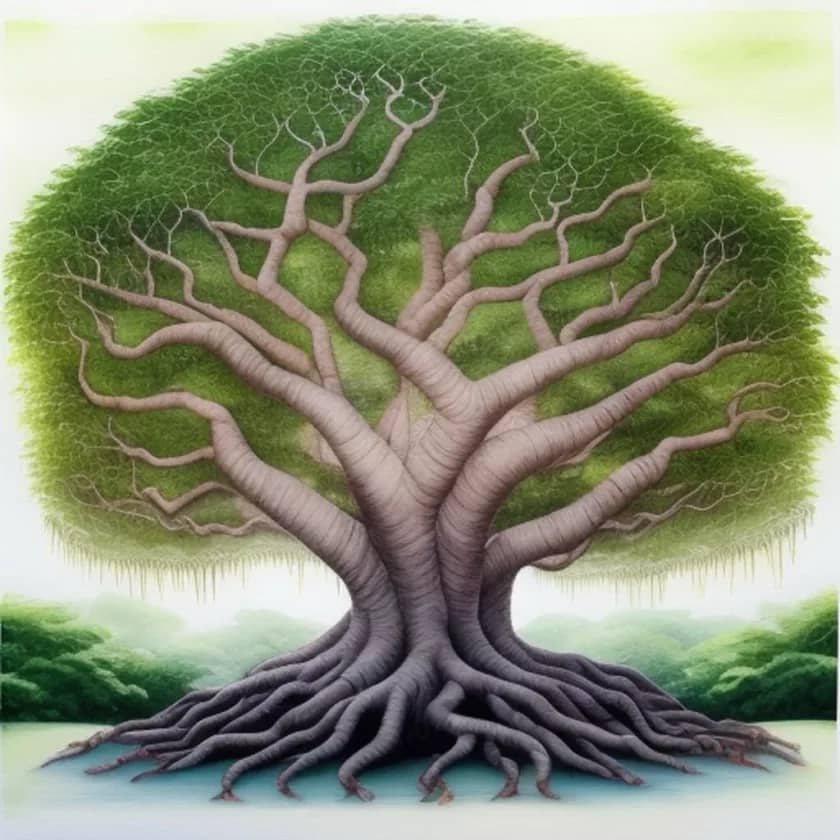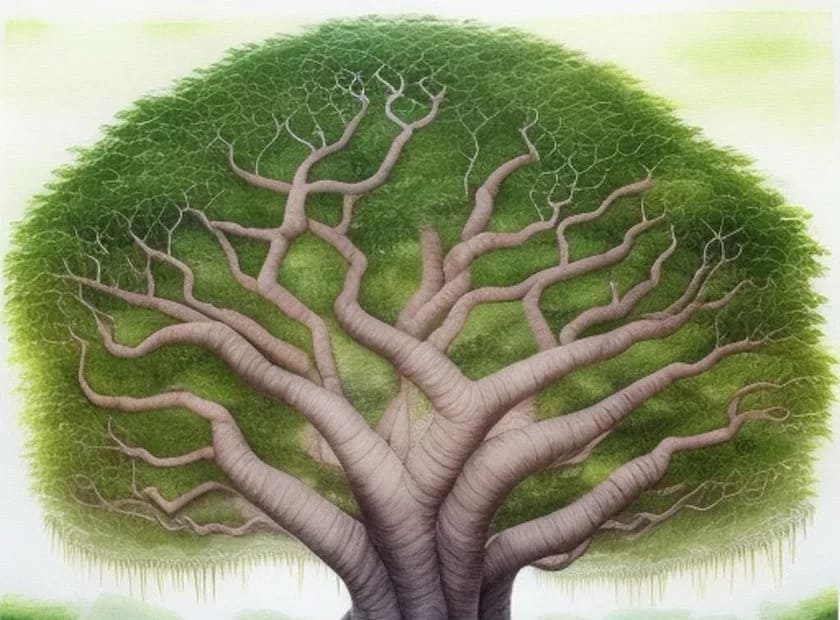Banyan aka Speaking tree
In Hinduism, the banyan tree is considered sacred and is often associated with Lord Krishna. It’s known for its expansive aerial roots that create a canopy, symbolizing interconnectedness and the unity of all life
The Banyan tree (Ficus benghalensis) holds great significance in Hinduism and is considered sacred for several reasons. One of the most prominent associations is with Lord Krishna, a central figure in Hinduism, particularly in the Bhagavad Gita and other sacred texts.
Some key aspects of the Banyan tree’s symbolism in Hinduism
Lord Krishna’s Childhood: According to Hindu mythology, Lord Krishna spent his childhood in the town of Vrindavan, where Banyan trees were abundant. He is often depicted playing under the shade of these trees, particularly the Peepal (Ficus religiosa) and Banyan trees.
Symbol of Immortality: The Banyan tree is known for its longevity and ability to grow and spread for centuries. This characteristic is often associated with the idea of immortality and the eternal nature of the soul, a concept important in Hinduism.
Interconnectedness: The Banyan tree’s distinctive feature is its expansive aerial roots that hang down and take root in the ground, creating a network of interconnected branches and trunks. This interconnectedness is seen as a symbol of the unity of all life forms and the interconnectedness of all living beings.
Shade and Shelter: Banyan trees provide ample shade and shelter to those who seek refuge under their vast canopy. This aspect is metaphorically linked to the idea of divine protection and nurturing care, as Lord Krishna is considered a protector and nurturer of his devotees.
Spiritual Significance: Many people in India and followers of Hinduism consider Banyan trees as sacred and offer prayers and rituals under their shade. They are often associated with meditation and spiritual practices.
Peepal and Banyan Trees: Both the Peepal tree (Ficus religiosa) and the Banyan tree are revered in Hinduism. The Peepal tree is associated with Lord Buddha’s enlightenment, while the Banyan tree is more closely linked to Lord Krishna.
In addition to its religious significance, Banyan trees are also ecologically important, providing habitat and sustenance for various organisms due to their unique growth pattern. Overall, the Banyan tree’s symbolism in Hinduism reflects its deep-rooted cultural and spiritual significance in the Indian subcontinent.
Species, characteristics, botanical information, use, ecological importance
The Banyan tree (Ficus benghalensis) is a remarkable species with distinctive characteristics, significant ecological importance, and various uses. Here’s more detailed information about this tree:
Species and Botanical Information
- Scientific Name: Ficus benghalensis.
- Common Names: Banyan tree, Indian Banyan, Bargad (in Hindi), Vad (in Gujarati).
- Family: Moraceae.
- Distribution: Banyan trees are native to the Indian subcontinent and can also be found in other parts of South Asia, Southeast Asia, and some tropical regions. They are often cultivated in other parts of the world for their ornamental value.
Characteristics
Size: Banyan trees are among the largest trees in the world. They can grow up to 100 feet (30 meters) or more in height, with a spread that can cover several acres.
Aerial Roots: One of the most distinctive features of Banyan trees is their aerial roots. These roots grow from the branches and hang down to the ground. Upon reaching the ground, they can take root and develop into new trunks, creating a labyrinthine structure.
Leaves: The leaves of the Banyan tree are elliptical or ovate, dark green, and glossy. They are alternate and simple.
Fruits: Banyan trees produce small, spherical figs that start green and turn reddish-purple when ripe. These figs are an important food source for various birds and animals.
Bark: The bark of mature Banyan trees is grayish and smooth.
Uses
Religious and Cultural Significance: As mentioned earlier, Banyan trees hold religious and cultural importance, especially in Hinduism. They are often used as places for meditation, prayers, and religious ceremonies.
Shade and Ornamental Value: The massive canopy of Banyan trees provides excellent shade, making them popular choices for parks, gardens, and public spaces.
Wildlife Habitat: Banyan trees offer shelter and food to a wide range of wildlife, including birds, insects, and small mammals, thanks to their fruit production and complex structure.
Timber: While Banyan wood is not commonly used for commercial purposes due to its soft and brittle nature, it can be used for small-scale woodworking and making handicrafts.
Traditional Medicine: Various parts of the Banyan tree, including the leaves, bark, and aerial roots, have been used in traditional medicine for their potential therapeutic properties.
Ecological Importance
Biodiversity: Banyan trees support a diverse ecosystem by providing habitat and sustenance to numerous species of animals and plants.
Soil Erosion Control: The extensive root system of Banyan trees helps prevent soil erosion, particularly in regions with heavy rainfall.
Carbon Sequestration: Like all trees, Banyans play a role in absorbing carbon dioxide from the atmosphere and mitigating climate change.
Water Table Stabilization: Banyan trees are known to help stabilize the water table, as their roots can access and absorb groundwater.
Urban Heat Island Mitigation: Planting Banyan trees in urban areas can help reduce the urban heat island effect by providing shade and cooling the environment.
In summary, the Banyan tree is a culturally significant and ecologically valuable species known for its massive size, aerial roots, and the intricate ecosystems it supports. It plays a crucial role in maintaining the balance of nature in its native regions and has various uses in human culture and traditional practices.
Resumed in a table
| Aspect | Description |
| Species | Ficus benghalensis |
| Common Names | Banyan tree, Indian Banyan, Bargad (in Hindi), Vad (in Gujarati) |
| Family | Moraceae |
| Distribution | Native to the Indian subcontinent, found in South Asia, Southeast Asia, and some tropical regions |
| Size | Can grow up to 100 feet (30 meters) in height with a wide canopy covering several acres |
| Aerial Roots | Distinctive feature, roots grow from branches and take root upon reaching the ground |
| Leaves | Elliptical or ovate, dark green, glossy, alternate, and simple |
| Fruits | Small, spherical figs that turn reddish-purple when ripe, important food source for wildlife |
| Bark | Grayish and smooth in mature trees |
| Uses | – Religious and cultural significance – Shade and ornamental value – Wildlife habitat – Timber for small-scale use – Traditional medicine |
| Ecological Importance | – Biodiversity support – Soil erosion control – Carbon sequestration – Water table stabilization – Urban heat island mitigation |
This table provides a concise summary of the various aspects of the Banyan tree, including its botanical information, characteristics, uses, and ecological importance.
A place of gathering and discussion
A place of gathering and discussion can serve as a vital hub for communities to come together, share ideas, and engage in meaningful conversations. Such places can vary in form and function, ranging from traditional physical spaces to virtual online forums. Here are some examples:
Community Center: Physical community centers often host a wide range of events, meetings, and gatherings. They provide a space for residents to discuss local issues, organize activities, and build a sense of belonging.
Cafes and Coffee Shops: Coffee shops have long been popular venues for casual discussions and meetings. They offer a relaxed atmosphere conducive to conversation.
Libraries: Libraries are not only places for quiet study but also for public lectures, book clubs, and community discussions. They promote intellectual exchange.
Town Halls: Town hall meetings are held in municipal buildings and are open to the public. They are platforms for citizens to interact with local government officials, ask questions, and voice concerns.
Online Forums: Virtual spaces like social media platforms, discussion boards, and forums allow people to gather and discuss topics of interest from anywhere in the world.
University Campuses: College campuses are often hubs for intellectual discourse. Students and faculty engage in academic discussions, lectures, and seminars.
Parks and Public Spaces: Parks and open areas can serve as informal gathering spots. People come together for picnics, discussions, and recreational activities.
Religious Institutions: Places of worship often host congregations for spiritual discussions and community gatherings.
Conference Centers: These venues are designed specifically for gatherings, conferences, and symposiums, where experts and professionals come together to exchange knowledge and ideas.
Online Webinars and Virtual Meetings: With the rise of digital technology, webinars and virtual meetings have become popular platforms for discussions, workshops, and seminars.
These gathering places, whether physical or virtual, play a crucial role in fostering dialogue, promoting social interaction, and facilitating the exchange of ideas. They are essential for building and strengthening communities and encouraging open and constructive discussions on a wide range of topics.
… and the banyan tree
The Banyan tree, with its vast and shaded canopy created by its aerial roots, has historically served as a symbolic and practical gathering place in some cultures. Here’s how the Banyan tree has been used as a gathering and discussion spot:
Traditional Gatherings: In parts of South Asia where Banyan trees are prevalent, they have often been chosen as natural gathering spots for village meetings, discussions, and communal activities. The shade provided by the tree’s expansive canopy offers relief from the sun, making it a comfortable place for people to come together.
Spiritual Gatherings: Banyan trees are considered sacred in Hinduism, and people often gather under them for religious and spiritual discussions, prayers, and meditation. These trees are believed to have a calming and spiritually uplifting ambiance.
Cultural Events: Banyan trees have been the backdrop for cultural events, such as storytelling sessions, folk performances, and traditional ceremonies. The natural setting of a Banyan tree lends itself well to such events.
Informal Discussions: In more urban settings, Banyan trees in parks or public areas can serve as informal discussion spots. People may sit under the tree to have casual conversations, read, or share ideas.
Historical and Educational Discussions: In some historical contexts, Banyan trees were used as sites for educational gatherings and discussions. Scholars and teachers would gather their students under these trees for lectures and debates.
While the Banyan tree may not be the primary gathering place in many modern urban settings, it still holds cultural and symbolic significance as a place where people can come together, discuss, and connect with nature. Its association with interconnectedness and unity aligns well with the concept of gathering for discussion and communal exchange of ideas.

Banyan tree also called the “speaking tree” …
The Banyan tree is often referred to as the “speaking tree” in some cultures and contexts. This nickname highlights the Banyan tree’s association with gatherings, discussions, and storytelling, where people come together to share their thoughts and wisdom.
In many cultures, especially in parts of India, the Banyan tree has been used as a backdrop for storytelling sessions, folk tales, and discussions. Under the shade of its expansive canopy, people would come together to exchange stories, legends, and knowledge, making it a place where the tree itself seems to “speak” through the voices and stories of those who gather beneath it.
The term “speaking tree” symbolizes the idea that the Banyan tree is not just a physical entity but also a spiritual and cultural symbol that connects people and allows them to communicate and share their insights and narratives. This nickname underscores the Banyan tree’s significance as a place of conversation, communal wisdom, and cultural exchange.
In some places it associated with cemeteries
In many cultures, the Banyan tree, with its expansive canopy and symbolic significance, is indeed associated with cemeteries or burial grounds. It is seen as a place where people can gather to remember and honor the deceased.
However, the specific tree species planted near cemeteries can vary widely depending on regional traditions, climate, and landscaping preferences. Some cemeteries may have various tree species, including evergreen trees like pine or spruce, deciduous trees like oak or maple, or ornamental trees like cherry blossoms. The choice of trees often depends on the local context and cultural practices.
In summary, the Banyan tree has deep cultural and spiritual significance in Hinduism and Indian culture, as well as associations with gatherings and discussions. In some cases, it may be found near cemeteries for remembrance.
A poem for the banyan tree as a sacred space, gathering peole and elevating all souls to higher dimensions
Beneath the sacred Banyan’s grand embrace,
A temple of nature’s grace, a hallowed space,
Its roots, like threads of time, reach deep and wide,
Inviting souls to gather, hearts open wide.
In dappled shade where seekers find their way,
A haven for discourse, both night and day,
With whispers of the past and dreams untold,
The Banyan’s mystic branches gently hold.
Its leaves, like pages of wisdom, rustle free,
Revealing secrets of the earth and sea,
As seekers congregate, their spirits soar,
To higher realms, beyond the earthly shore.
Amidst the hum of life, a tranquil sigh,
Beneath the Banyan’s branches, we comply,
To nature’s sacred temple, we ascend,
In unity and peace, our souls transcend.
The Banyan, ancient sentinel of lore,
A gathering place where hearts and minds explore,
Elevates our thoughts to dimensions high,
A timeless temple ‘neath the endless sky.
So let us gather ‘neath this sacred tree,
In nature’s temple, boundless and free,
To elevate our souls, in unity we rise,
Beneath the Banyan’s canopy, we touch the skies.
Thank you for likes, shares and comments! 🌳🌴🌲🌵
Source OpenAI’s chatGPT Language Models, Dalle, AI trot and Fleeky
images Picsart and MIB
Invest in your future
Take time to learn
Embark on your journey in affiliate marketing and website creation alongside an incredible community and myself. Invest in your future by dedicating time to learn and earn. Take all the time you need to master the basics before aiming higher. Give it a try and sign up for free. You won't regret it! Discover the possibilities for yourself...


